| | | | February 2021  Dispatch subscribers: keep an eye on your email for a personal invitation to watch a Live Broadcast of The Inaugural Raising of the Flag of the United States of America over the National World War I Memorial in Washington, DC, featuring award-winning actor Gary Sinese and many other notable speakers. Not a subscriber? Subscribe now to be sure you receive your own invitation to watch this historic broadcast. | |  It's 58 feet long and 10 feet high:
New Jersey sculptor's World War I monument will speak for a nation An in-depth look at the process of creating the sculpture for the new National World War I Memorial in Washington, DC was recently published on the NorthJersey.com web site, and later picked up for national viewership by USA Today. Reporter Jim Beckerman interviews sculptor Sabin Howard and the whole team at his studio. Click here to read the entire interview, and watch the absorbing video. Click here to register TODAY to attend this FREE 2021 webinar for educators and learners about the challenges, opportunities and importance for teaching and learning about "The War That Changed the World". "WWI Education Webinar: Strategies and Tools for Teaching (and Learning) WWI in 2021" on Feb 26, 2021 1:00 PM EST -- today. https://attendee.gotowebinar.com/
register/1274955613107522318 After registering, you will receive a confirmation email containing information about joining the webinar. Can't attend today? Register anyway to receive a link to the recording later. New Book Gives Voice to the Men of the Famous Lost Battalion of World War I 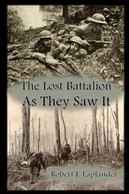 In the history of American participation in WWI, two stories remain the most recognized: that of Sergeant York, and that of the 'Lost Battalion.' Now another chapter in the tale of the Lost Battalion has been told in a new book by WWI author and historian Robert J. Laplander titled The Lost Battalion: As They Saw It. Most know the general story. Between October 2nd and October 7th, 1918 Major Charles Whittlesey of the 77th Division led nearly 700 men into the narrow Charlevaux Ravine during the battle in the Argonne Forest. They were quickly surrounded by the Germans and during their five-day siege in that ravine endured starvation, continual enemy attacks, a mistaken artillery barrage by their own forces, and an eventual casualty rate of nearly 72%. Click here to learn more about this new book that tells the Lost Battalion's story through the words of its survivors.. | 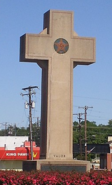 The Bladensburg World War I Memorial, known as the Peace Cross, in Prince George's County, Maryland, which includes the names of four Black soldiers who died in World War I, needs money for restoration. Calls for funding are being made specifically during Black History Month. "Funds are needed to begin this vital endeavor. To address the need, the Department of Parks and Recreation is fundraising to repair the Peace Cross," Department Resource Development Officer Tracy Wright said in a news release. "We encourage the community to join us and help support the restoration of this historical monument which honors our fallen Black heroes." Click here to learn more about the Peace Cross, the heroes it honors, and how its restoration can be supported. | 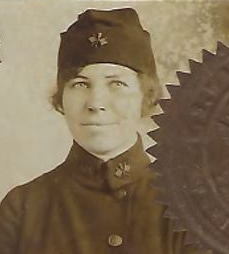 In World War I telephone operators were needed in Europe. General John J. Pershing, commander of the American Expeditionary Forces during World War I, quickly saw that women—American women–would be better at telephone work than the men. The Signal Corps was all male, and they were not only assigned to string lines but to handle all communications, and were not doing well at the latter task. A call was put out throughout America for women to serve in Europe as operators. The preferred candidates were fluent in French and English. One of the women who answered the call was Marguerite Martin. Click here to read Marguerite's story, and learn how important the "Hello Girls" were to the American Expeditionary Forces in World War I. | 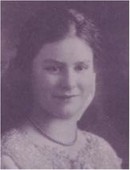 "Grandma, do you know how to knit?" It was the summer of 2000 and eleven-year-old Lizzie, a beginning knitter, hoped she'd found a mentor—her ninety-four-year-old grandmother, Mary Elting Folsom. Lizzie's question took Mary back to 1917, several months after the US entered World War I. "Yes, Lizzie, I do know how to knit. I learned during the summer of 1917, when I was eleven. Surprisingly, my teacher was a British army recruiter who had come to my home town of Creede, Colorado." Located high in the San Juan mountains of southern Colorado, Creede was a silver mining town when Mary was born in 1906. Click here to read Mary's story, and learn the surprising reason that a British army recruiter was there in 1917 to provide knitting lessons to her. | 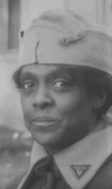 When Kathy Coker was doing research at the Richmond, VA Public Library, In preparation for Black History Month, she uncovered the fascinating story of Addie Waites Hunton, an African American suffragist, activist, writer, political organizer, educator, and officer of the the Young Women's Christian Association (YWCA). If all that wasn't enough to make Hunton a noteworthy historical figure, she also became involved in the YMCA's work abroad during World War I, travelling to France in June 1918 to work with the black troops of the American Expeditionary Forces. Click here to read the entire amazing story of Addie Waites Hunton, and the astonishing and outsized role she played in American history. |  When the United States military went "over there" to take on the Huns (the Germans) during the First World War, what it lacked in equipment it more than made up for in determination. This meant that Americans often relied on foreign equipment, and in the case of aircraft the American Expeditionary Force (AEF) used what it could get. After the French rejected the Nieuport 28C.1, which was introduced in mid-1917, in favor of the far sturdier and more advanced Spad XIII, the newly arrived Americans adopted the Nieuport 28 as a stop-gap measure, and quickly the American pilots made do with what they could. Click here to read more about how American aviators with obsolete equipment were nevertheless able to perform prodigious aviation feats in WWI. | 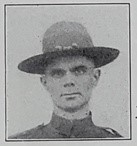 A man is only missing if he is forgotten. Our Doughboy MIA this month is Private Samuel Roach. Born February 12th, 1886, in Bradford, Ohio, Private Roach was an employee of the E.C. Atkins Saw Works in Indianapolis when he enlisted in the U.S. Army on October 16th, 1917. Sent to Ft. Thomas, Kentucky for muster, he took his training at Washington D.C., where he was assigned to Company D, 6th Engineer Regiment, 3rd Division. He left for overseas on December 6th, 1917, and was killed in action on March 29th, 1918 near Villers Bretonneux. He is memorialized on the Walls of the Missing at the Somme American Cemetery, Bony, France. Interestingly, he was initially reported to the state of Indiana as having been returned and interred at Arlington national Cemetery. Can you spare just ten dollars? Give 'Ten For Them' to Doughboy MIA and help us make a full accounting of the 4,423 American service personnel still listed as missing in action from WW1. Make your tax deductible donation now, with our thanks. |  No longer available from the U.S. Mint! These Official World War I Centennial Silver Dollar Sets are still available here on the WWI Centennial Commission's online gift shop. NOTE: Each set comes with 2 separate coins. Each set will accompany the Official Doughboy Design alongside your choice of Military Branch. "The United Mint certifies that this coin is a genuine 2018 World War I Centennial Silver Dollar, minted and issued in accordance with legislation passed by Congress and signed by the President on December 16, 2014, as Public Law 113-212. This coin was minted by the Department of the Treasury, United States Mint, to commemorate the centennial of America's involvement in World War I. This coin is legal tender of the United States." | | | |  Submitted by: Michael Conn {Great Grandson} Frank Clyde Mercer was born around 1887. Frank Mercer served in World War 1 with the United States Army Air Corps. The enlistment was in 1918 and the service was completed in 1918. Story of Service The service of Franklin "Clyde" Mercer in the First World War began in support of the war effort as a 30-year-old, civilian, munitions worker for the Whitaker Glessner Company, a steel production company contracted to manufacture 155mm howitzer shells at its location in New Boston, a small Ohio village within the city of Portsmouth, Ohio. Frank's military draft paperwork show that he was employed with Whitaker Glessner on June 5, 1917, the date of his registration for the draft. Eleven months later, on May 17, 1918, Frank would enter military service. He was accompanied by his uncle, Harzy Walls, 6 months his junior, who was also entering the service. Now 31 years of age, Frank departed the Ohio River Valley for Camp Sevier, a military training camp located in the upstate of South Carolina, near the city of Greenville. It was here, following their formal induction and training into the Air Service of the National Army, that Harzy and Frank would part ways. Frank was assigned to the 15th Aero Construction Company as a carpenter and would spend the early summer months getting technical training at Camp Mills and Hazelhurst Field, near Garden City, New York while Harzy would train near Norfolk, Virginia at Camp Morrison with the 27th Balloon Company for the remainder of the war.
|  | | | |


No comments:
Post a Comment
Keep a civil tongue.